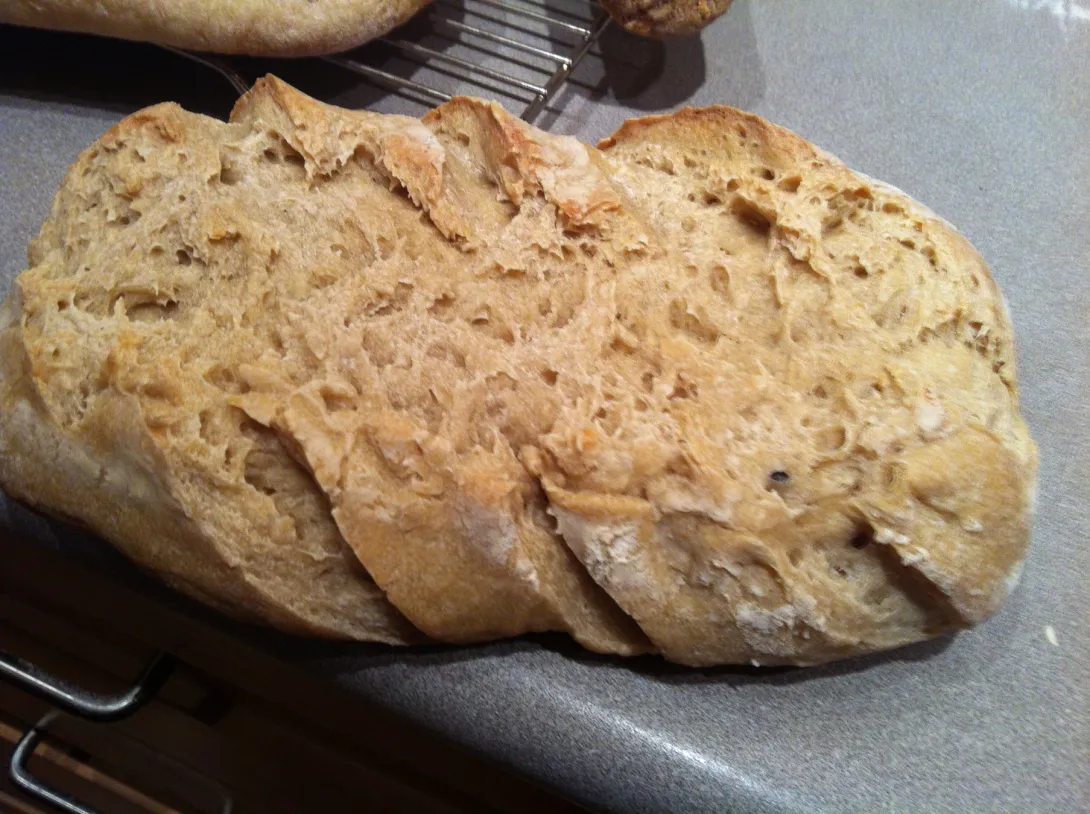
Does this look like overproof to you? I've been having trouble recently getting my dough to rise because it's gotten pretty cold lately. I think I've gone to far the other way now.
I usually do a preferment the day before baking, then bulk proof the final dough in the fridge overnight. In the morning I divide and shape then leave in a couche until baking.
The change I've made is to put the bulk dough into the oven (on proof) setting in the morning to complete the bulk proof.
This is the result.
What you're seeing isn't ovenspring. The dough started to tear before I put it in the oven. The dough spread and dropped in the oven, which only increased the tearing.
I use my own recipe, with the combination of all purpose and light rye flours I also add 4% vital wheat gluten. The dough did seem a little wetter than usual, which I'm now thinking might be caused by the cold humid weather. No where for the liquid to evaporate to, like there was in summer.
I don't add yeast. If my starter is looking a little tired I add a slice of apple for a pick-me-up.
This dough, the total hydration is 68%.
I'll get a picture of the interior tomorrow.
Thanks
Another interesting note is that the baguettes I made with the same dough at the same time were less affected. They are proofed in metal perforated baguettte pans. I'm not sure why that should make any difference. The loaves are well supported by my hemp couche during final proof.
Thanks for your help!
I second adri's comment that it is under proofed for the same reason.
You might want to try increasing your pre-ferment % a bit to compensate for cooler temperatures.
Janet
the pale crust colour is also crying out over proofed.
If your recipe has over 40% rye, try developing the wheat flour gluten first before adding the rye & starter and see if that helps. As the amount of rye increases in the recipe, it becomes more important to raise the pH in the dough so the rye can stretch before it wears out. If a lot of rye is in the formula, warm proofing can rip the dough as the gas is being produced faster and expands more than the dough can stretch. Proof cooler (not cold) and thus slower. slowing down the yeast in the dough. Rye blends tend to like cooler slower rises. If you have a spare room that is warmer than the fridge but cooler than the kitchen, that might be the place for a long cool rise.
Oh, thanks Mini. I didn't know that rye doesn't like a warm proof, though it makes sense when I think about it. I've been trying to counter the cooler temps by bulk proofing in the oven (on the proof setting), but it sounds like what I ought to do is just let it proof longer at this cooler temp. I'm pretty sure the fridge is getting the dough too cool.
The rye percentage is not that high, only about 5% in the final dough and 30% in the starter.
to your loaf. But any amount of rye will speed up fermentation. You mentioned adding apple to your tired starter but if the starter is tired and shows a lot of decreased activity, you might be better off refreshing the starter instead of using one that is full of rapidly deteriorating enzymes. The dough could be just too tired to hold itself together.
I would find a flour with a higher ash content for longer ferments as opposed to adding more gluten.
Do you mean by that regular feeding? I feed my starter before and after using. Water:all purpose:rye (10:7:3). Is there something else meant by refreshing?
What do mean by ash content? I was taught that higher ash content was a lower quality flour and what makes a good bread flour (strong gluten production) is the protein content.Could you explain why I would us a higher ash content flour, please?
How much starter to your S:10:10 feeding? 1? 10? And do you use it when it is at full volume or peaking?
http://www.thefreshloaf.com/node/2360/ash-content-and-protein-s
Thanks for the link to ash content. I think the more I learn, the more I realize there is so much more to learn.
Again, I am confused by your language. What is the difference between "full volume" and "peaking"?
I try to use the starter as close to to point just before it falls.
I have to admit the feeding ratio is not that regular. The day before I bake I calculate how much starter I will need and I feed the starter so that I will have enough for baking plus around 100g to save for next time. The day I bake I feed that remaining 100g with 100g (50g water, 15g rye, 35g AP). Hope that makes sense.
less, actually 50g of flour as food. Hmmm, I would be feeding it at least 100g flour. To me, it looks like the starter is underfed. Might want to save only 50g starter (or less) and feed 50g water and 50g of mixed flours. But maybe you got cold temps or you are chilling the starter right away after feeding. If you feed more flour (more than the starter) when building for use, you give the yeasts a better chance to multiply. That might be the solution, beef up the yeasts in the starter (!) the rise will then be quicker before the integrity of the dough is exhausted and falls apart... like in the posted picture.
Full volume, peaking, all the same in referring to the fist rise after feeding. Sounds right. Catching the peak before it falls, just checking. Warm proofing the starter or build when the food is less than the ripe starter amount translates into incredibly fast fermentation.